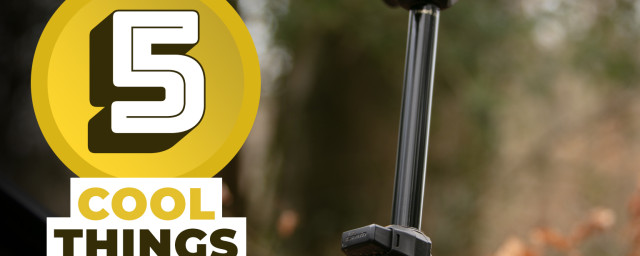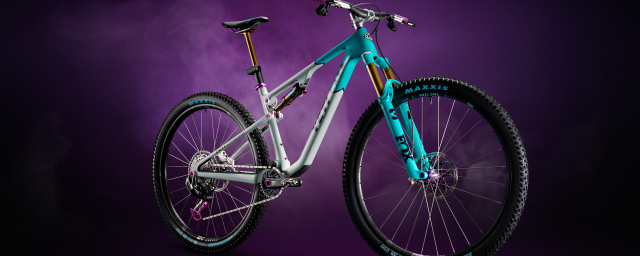Built for ‘anything you throw at ‘em’, WTB’s Wavelength grips are incredibly tough to fault. They’re simple with a clever texture design that damps low-level vibration while rustling up plenty of traction and all-day comfort. However, the soft rubber does raise some durability concerns and I didn’t expect the price to be quite high.
- MTB cockpit setup - How to clean up your handlebars
- Lizard Skins Strata single clamp lock-on grip review
- Best MTB grips 2024 - options to improve your comfort and handling
WTB Wavelength grips - Technical details
Earlier in 2024, WTB expanded its offering with four new grips and the Wavelength is said to improve handlebar control and boost comfort over the lumpy stuff.
With that in mind, it benefits from a pattern that’s not too dissimilar to PNW’s Loam grip in that it employs a multi-directional, almost mushroom-like fin texture. That’s paired with a more conventional waffle at the fingertips.
These textures form a taper, measuring from 30mm inboard to 32mm in diameter outboard. WTB says this, combined with an asymmetric design that’s thinner at the bottom, adds more cushion and helps resist wear and tear. The rubber utilised for this grip is an ‘Anti-Slip’ rubber.
As with many of the best MTB grips, the Wavelength uses a single-sided locking collar, and the inner sleeve is tapered for comfort.
Available in one size, these grips can be picked up in either the tan colour (pictured here) or black. They measure 140mm and weigh 115g.
WTB Wavelength grips - Performance
There are two things that I liked from the very start – the simplicity and the tapered shape. Where loads of grips in the price range come with complicated designs and contours for traction and ergonomics, WTB’s efforts towards the Wavelength feel modest. But where the grip isn’t trying to push boundaries, it meets an excellent middle ground, providing plenty of traction and comfort.
Setup, as with any grip, was fairly straightforward. The finger waffle portion is fairly small so finding a position where my fingers were comfortable took a little bit of trial and error.
The Wavelength does a solid job of providing a lot of traction with minimal effort from the rider. So you can ride with a somewhat loose grip without their hands shifting around. This reduces the likelihood of arm pump and fends off fatigue later into a decent.
Then, because of the arrangement of the fins, there’s a smidgeon of movement in the rubber itself, which helps absorb vibrations. It also allows the grip to move under the hand, similarly to Revgrips, but nowhere near as freely. Of course, the softer durometer rubber aids the cause, as does the thicker rubber found towards the upper of the grip.
Despite the thick rubber and the bit of movement provided by the fins, bar feel is pretty much as you would expect. That's a credit to the semi-asymmetric design where the finger portion has minimal texture and less rubber, so your fingers are closer to the bar. However, if you're not a fan of tapered grips, you won't gel with the Wavelength.
The bar ends are squishy, too, and, as someone who rides with a bit of their palm hanging off the edge, this is a serious plus. It completely avoids discomfort from a firm outer-locking collar.
This does come with a disadvantage, however, and that’s durability. Having the bike in the back of a van, leaning against a wall or just having the grip take the brunt of fall, one grip end has torn deep enough to expose the core. In the grand scheme of things, that’s no big deal but I’ve seen greater durability from grips south of the Wavelength’s asking price.
WTB Wavelength grips - Verdict
And that’s where the main problem with the Wavelength lies, it’s unexpectedly pricey. Before putting a bit of research into the grip, I was expecting it to sit around the £20 to £25 mark, where it would be an incredibly competitive option – but, at £30, some grips push ergonomics much harder.
One of those is the SQlab 70X which is built with contours that support the hand. For the best results, it's required that your hands are measured to find the right size. That said, the contours might not be for everyone.
A serious contender is ODI’s Reflex grips. In a sense, they're similar but, in practice, they do the job better with improved vibration damping. They also use ODI’s super-slim locking collars so there’s a lot of surface area to play with. They’re just not tapered.
At £25 a pair is PNW’s excellent Loam grips. They’re still a personal favourite and, to a point, their design isn’t a stone’s throw away from the WTB. These are designed to absorb vibrations while wicking moisture away from the hands. They’re built with a great rubber compound that errs more towards durability but without sacrificing grip. Better yet, there are more colours to pick from, as well as two sizes.
Although I would expect a little bit more for the money, the WTB Wavelength does exactly what it says on the tin, which is a sure sign of a job well done. It damps vibration and provides more than enough traction with little effort, thus remaining comfortable and keeping arm pump at bay. Even though the soft rubber does great things for the grip on offer, it does make it prone to damage.















Add comment